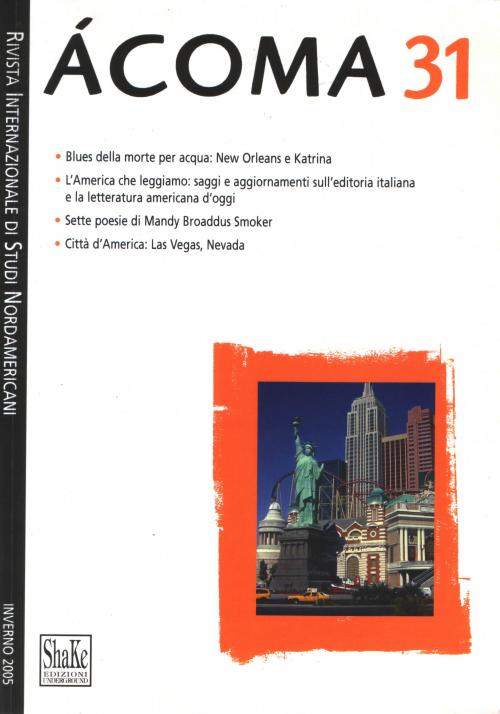Tu sei qui
L'America che leggiamo
Numero 31
Inverno 2005 - Anno XII
 Blues della morte per acqua: New Orleans e Katrina
Blues della morte per acqua: New Orleans e Katrina
 L'America che leggiamo
L'America che leggiamo
 Sette poesie di Mandy Broaddus Smoker
Sette poesie di Mandy Broaddus Smoker
 Città d'America: Las Vegas, Nevada
Città d'America: Las Vegas, Nevada
Katrina
Blues della morte per acqua: ricordando New Orleans - p. 5
By weaving together personal memoir and factual account, history and culture of New Orleans and its environs, and by drawing on journalistic reports as well as on poems, songs, and novels, Mario Maffi’s essay argues why Katrina (and Rita) cannot be considered “natural catastrophes”, but one which has its roots deeply in the U. S. economy, politics and social structure.
L’America che leggiamo: saggi e aggiornamenti
L’America che leggiamo - p. 17
“Contro ogni armonia è il disegno vistoso e scombinato” - p. 21
The canon of American women’s literature established by Italian publishers in the last three decades is strikingly different from what is being published, read and thought in the US. Focusing on the editorial choices made by the most important feminist publisher in Italy, La Tartaruga, this paper argues that, unlike American feminists, Italian feminists have tended to favor works marked by formal experimentalism and predominantly concerned with gender issues. Women writers who focus on class, race, and ethnicity or seem to neglect aesthetic issues have often been ignored. Taking the 1976 Italian translation of the “Yellow Wall-Paper” as a case study, this paper shows how the two Italian translators transformed a pragmatic text with an overt political agenda – almost a cautionary tale – into an example of écriture féminine.
Una disattenzione curriculare: la letteratura americana nelle scuole secondarie superiori - p.33
What kind of attention is paid to American literature in the high-school syllabus of English as a foreign language? This is the starting point for a survey of recent and less recent anthologies of English literature, targeted on Italian teenagers attending secondary schools. The essay deals with the cultural and ideological patterns at work in the editorial presentations of American writers, either de-nationalized under the common aesthetic experience of the language they share with their English partners, or linked with the colonial lore and thematized according to ethnical cathegories.
Elogio della sconfitta. A Fan’s Notes di Frederick Exley - p. 39
The essay centers upon Frederick Exley’s memoir A Fan’s Notes, recently appeared in Italian translation, thirty-seven years after its publication in English in 1968. The book, a fictional memoir, is being discussed here as an example of a masterpiece of modern American fiction earning its author, though unofficially, somewhat of a cult following, thanks to its combination of a powerful literary style and pitiless description of contemporary America, seen as a world of extremes: bewildered misfits and desperate failures— as Exley regarded himself to be—on one side, and successful celebrities, such as Frank Gifford, star of the New York Giants, on the other. Still, in spite of all its merits, and of its having represented a definite source of inspiration for an entire generation of contemporary American writers, Exley’s work seems to have been slowly and deliberately reduced to silence, as if his fictional world, as well as his entire life (Exley died in 1992) were too eccentric, critical, and embarrassing to be safely accomodated within the official literary canon.
L’America come genere letterario - p. 46
The essay attempts a description of the ways in which a number of successful American authors and novels have been recently assimilated into Italian literary culture. Attention is devoted to Italian publishers, translators and reviewers who have arbitrarily given life to an American literary canon which is trans-national and stereotypical enough to be adopted by and accommodated into our tradition. By highlighting the connection between stylistic and ideological modes which are considered new and representative in both countries, the article also focuses on two recent Italian novels whose reworking of American plots and characters has managed to please young, sophisticated readers in Italy and elsewhere.
Schede
La letteratura degli afroamericani - p. 64
La letteratura indianoamericana - p. 69
La letteratura asiaticoamericana - p. 72
La letteratura ebreoamericana - p. 76
La letteratura dei Latinos - p. 80
La letteratura di fantascienza - p. 85
La letteratura horror e fantasy - p. 88
Pubblicare l’America: progetti e percorsi dell’editoria italiana - p. 90
Testo a fronte
Sette poesie di Mandy Broaddus Smoker, con una breve intervista - p. 98
Somewhere Over the Rainbow. Las Vegas e la tematizzazione dello spazio urbano in Nordamerica - p.
Las Vegas, one of the fastest growing cities in the North American continent, is an extreme case of America’s obsession with symbolization. As Robert Venturi taught a whole generation of architects to look “non-judgementally” at Las Vegas and at the way it redefined sign and substance, public and private space, a similar case can be made today: learning from Las Vegas’ multi-million dollar themed resorts may teach useful lessons on the nature of representation and symbolization in the American continent. This essay investigates the boundaries between pastiche and simulation, urban history and entertainment, urban space and total space, while trying to provide operative concepts suitable to make sense of a veritable other-place which more and more resembles the actual environments in which we lead our daily lives.

